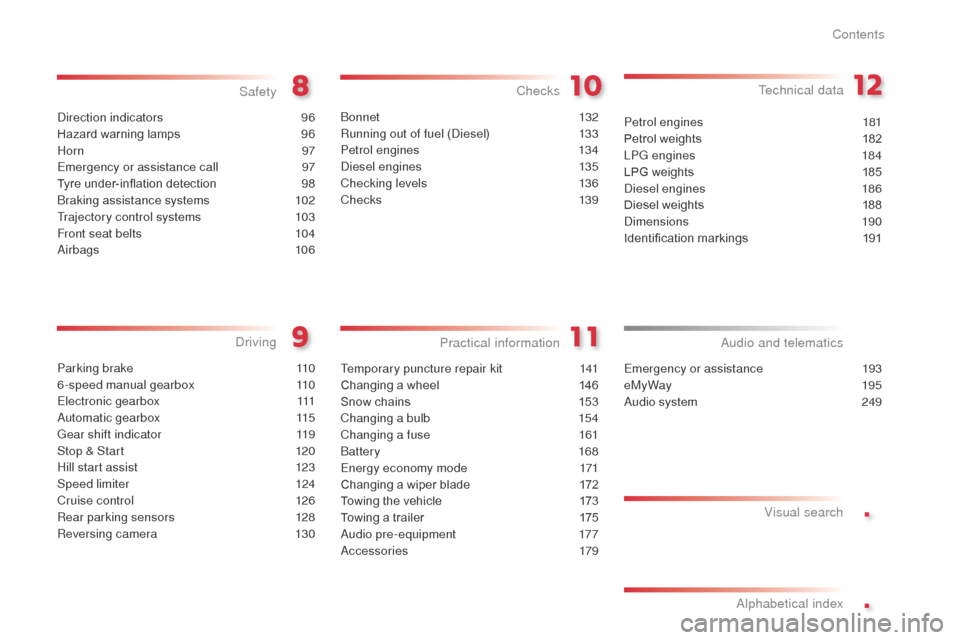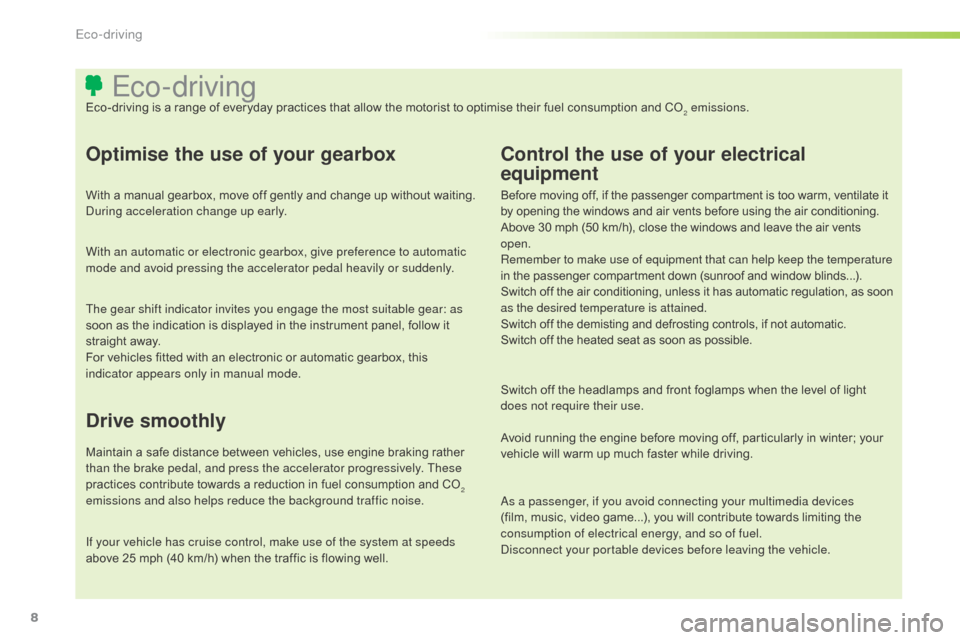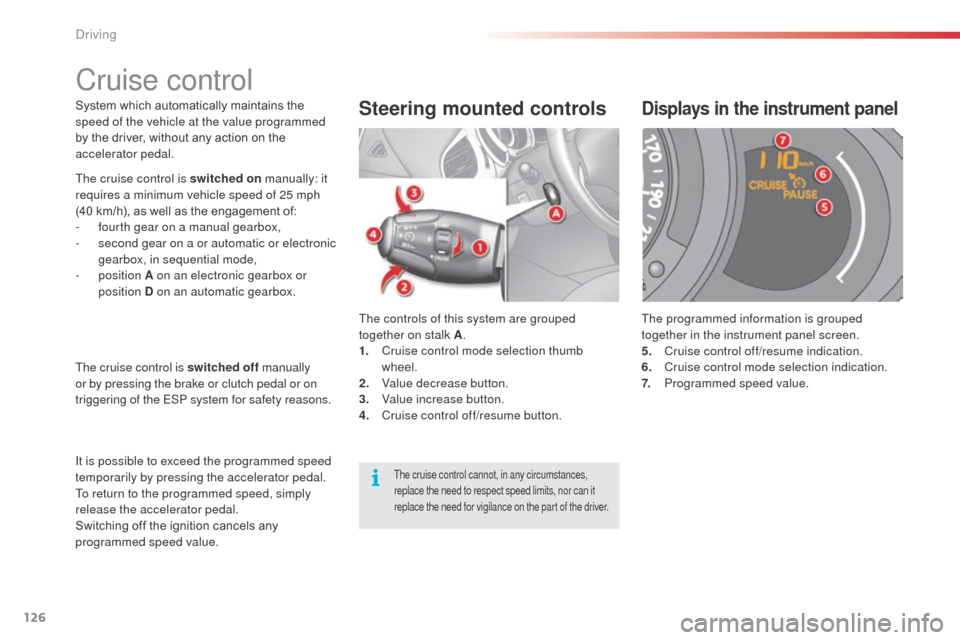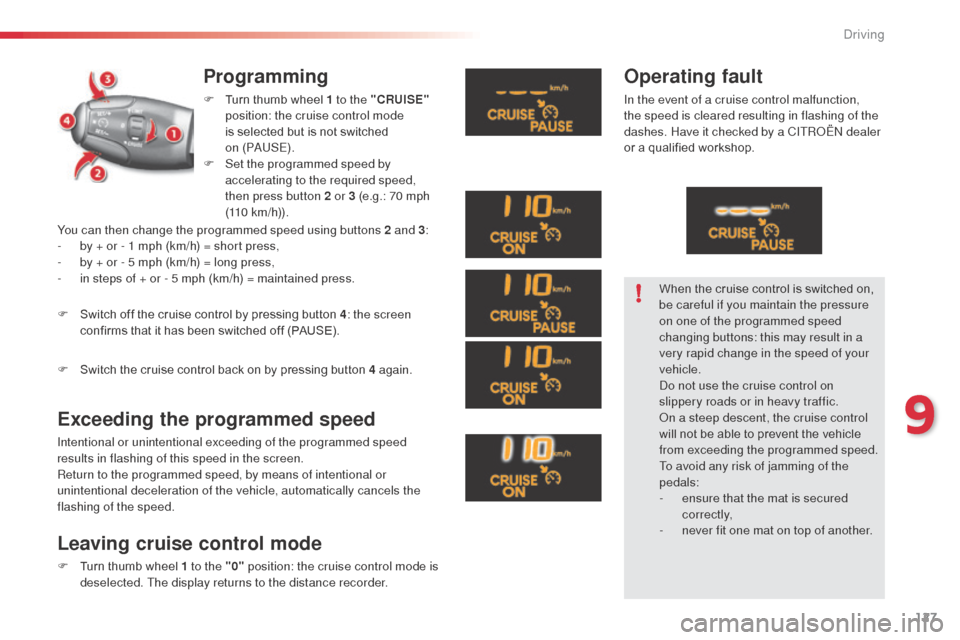Cruise Control Citroen C3 2014 2.G Owner's Manual
[x] Cancel search | Manufacturer: CITROEN, Model Year: 2014, Model line: C3, Model: Citroen C3 2014 2.GPages: 284, PDF Size: 9.01 MB
Page 5 of 284

.
.
C3_en_Chap00a_sommaire_ed01-2014
C3_en_Chap00a_sommaire_ed01-2014
direction indicators 96
Hazard warning lamps
9
6
Horn
97
E
mergency or assistance call
9
7
Tyre under-inflation detection
9
8
br
aking assistance systems
1
02
Trajectory control systems
1
03
Front seat belts
1
04
air
bags
1
06
Safety
Parking brake 1 10
6-speed manual gearbox
1
10
Electronic gearbox
1
11
au
tomatic gearbox
1
15
Gear shift indicator
1
19
Stop & Start
1
20
Hill start assist
1
23
Speed limiter
1
24
Cruise control
1
26
Rear parking sensors
1
28
Reversing camera
1
30
driving
Emergency or assistance 1 93
eMyWay
19
5
au
dio system
2
49
audio and telematics
al
phabetical index
bonnet 132
Running out of fuel (
di
esel)
1
33
Petrol engines
1
34
di
esel engines
1
35
Checking levels
1
36
Chec ks
13 9
Checks
Temporary puncture repair kit 1 41
Changing a wheel
1
46
Snow chains
1
53
Changing a bulb
1
54
Changing a fuse
1
61
bat
tery
168
Energy economy mode
1
71
Changing a wiper blade
1
72
Towing the vehicle
1
73
Towing a trailer
1
75
a
udio pre-equipment
1
77
ac
cessories
179
Practical information Technical data
Petrol engines 1
81
Petrol weights
1
82
LPG engines
1
84
LPG weights
1
85
di
esel engines
1
86
Diesel weights
1
88
di
mensions
190
Identification markings
1
91
Visual search
Contents
Page 8 of 284

6
C3_en_Chap00b_vue-ensemble_ed01-2014
Instruments and controls1. Cruise control / speed limiter controls.
2. Headlamp height adjustment.
3.
S
teering wheel adjustment control.
4.
L
ighting and direction indicator control stalk.
5.
I
nstrument panel.
6.
d
r
iver's airbag.
Horn.
7.
G
ear lever.
8.
1
2 V accessory socket
U
S
b
port / auxiliary socket.
9.
H
eated seat control.
10.
b
o
nnet release lever.
11.
d
o
or mirror controls.
E
lectric window controls.
R
ear doors and electric windows
deactivation switch.
12 .
Fusebox.
13.
S
top & Start deactivation switch.
E
lectronic stability deactivation switch
(
dS
C/
a
SR)
U
nder-inflation detection reinitialisation
switch (depending on version).
14 .
F
ront door window demisting/defrosting
vent.
15.
S
peaker (tweeter).
16.
W
indscreen demisting/defrosting vent.
over view
Page 10 of 284

8
C3_en_Chap00c_eco-conduite_ed01-2014
Eco-drivingEco-driving is a range of everyday practices that allow the motorist to optimise their fuel consumption and CO2 emissions.
Optimise the use of your gearbox
With a manual gearbox, move off gently and change up without waiting. during acceleration change up early.
With an automatic or electronic gearbox, give preference to automatic
mode and avoid pressing the accelerator pedal heavily or suddenly.
Drive smoothly
Maintain a safe distance between vehicles, use engine braking rather
than the brake pedal, and press the accelerator progressively. These
practices contribute towards a reduction in fuel consumption and CO
2
emissions and also helps reduce the background traffic noise.
If your vehicle has cruise control, make use of the system at speeds
above 25 mph (40 km/h) when the traffic is flowing well. The gear shift indicator invites you engage the most suitable gear: as
soon as the indication is displayed in the instrument panel, follow it
straight away.
For vehicles fitted with an electronic or automatic gearbox, this
indicator appears only in manual mode.
Control the use of your electrical
equipment
Before moving off, if the passenger compartment is too warm, ventilate it
by opening the windows and air vents before using the air conditioning.
Above 30 mph (50 km/h), close the windows and leave the air vents
open.
Remember to make use of equipment that can help keep the temperature
in the passenger compartment down (sunroof and window blinds...).
Switch off the air conditioning, unless it has automatic regulation, as soon
as the desired temperature is attained.
Switch off the demisting and defrosting controls, if not automatic.
Switch off the heated seat as soon as possible.
Switch off the headlamps and front foglamps when the level of light
does not require their use.
Avoid running the engine before moving off, particularly in winter; your
vehicle will warm up much faster while driving.
as a p
assenger, if you avoid connecting your multimedia devices
(film, music, video game...), you will contribute towards limiting the
consumption of electrical energy, and so of fuel.
dis
connect your portable devices before leaving the vehicle.
Eco-driving
Page 28 of 284

26
C3_en_Chap01_Controle-de-marche_ed01-2014
C3_en_Chap01_Controle-de-marche_ed01-2014
The instrument panel remains illuminated with
only the vehicle speed and cruise control or
speed limiter information, if in use.
If there is an alert or a change in a function
or to a setting, the black panel mode is
interrupted.
Activation
F With the lighting on, press the left hand button of the instrument panel several
times to progressively reduce the
dashboard lighting level.
F
P
ress the button again to reduce the
lighting to the minimum level and switch off
the interior mood lighting.
F
P
ress the button again to activate the black
panel.
Black panel
System allowing certain displays to be switched
off for night driving.
Activation
When the lighting is on:
F p ress the button to change the brightness
of the instruments and controls,
F
w
hen the level of brightness required is
reached, release the button.
Deactivation
When the lighting is off, or in day mode on
vehicles fitted with daytime running lamps,
pressing the button does not have any effect.
Lighting dimmer
System for manual adjustment of the
brightness of the instruments and controls in
relation to the exterior brightness.
Monitoring
Page 82 of 284

80
C3_en_Chap06_amenagement_ed01-2014
Storage drawer
The storage drawer is located under the
driver's seat.
Opening
F Raise the front of the drawer and pull it.
Removal
F Bring the drawer to the end of its travel.
F
P ress the ends of the slides.
F
R
aise the drawer and pull it fully.
Refitting
F Engage the drawer in its slides.
F at t he end of its travel, press on the top of
the drawer to secure it.
Mats
Fitting
When fitting the mat for the first time, on the
driver's side use only the fixings provided in the
wallet attached.
The other mats are simply placed on the
carpet.
Removal
To remove the mat on the driver's side:
F m ove the seat as far back as possible,
F
un
clip the fixings,
F
r
emove the mat.
Refitting
To refit the mat on the driver's side:
F p osition the mat correctly,
F
r
efit the fixings by pressing,
F
c
heck that the mat is secured correctly.
To avoid any risk of jamming of the
pedals:
-
o
nly use mats which are suited to
the fixings already present in the
vehicle; these fixings must be used,
-
n
ever fit one mat on top of another.
The use of mats not approved by
CITROËN may inter fere with access to
the pedals and hinder the operation of
the cruise control / speed limiter.
The mats approved by CITR
oËn
have
two fixings located below the seat.
do n
ot place heavy objects in the
drawer. Removable carpet protection.
Fittings
Page 128 of 284

126
C3_en_Chap09_Conduite_ed01-2014
C3_en_Chap09_Conduite_ed01-2014
System which automatically maintains the
speed of the vehicle at the value programmed
by the driver, without any action on the
accelerator pedal.The controls of this system are grouped
together on stalk A.
1.
C
ruise control mode selection thumb
wheel.
2.
V
alue decrease button.
3.
V
alue increase button.
4.
C
ruise control off/resume button.Steering mounted controlsDisplays in the instrument panel
The programmed information is grouped
together in the instrument panel screen.
5.
C
ruise control off/resume indication.
6.
C
ruise control mode selection indication.
7.
P
rogrammed speed value.
The cruise control cannot, in any circumstances,
replace the need to respect speed limits, nor can it
replace the need for vigilance on the part of the driver.
Cruise control
The cruise control is switched on manually: it
requires a minimum vehicle speed of 25 mph
(40 km/h), as well as the engagement of:
-
f
ourth gear on a manual gearbox,
-
s
econd gear on a or automatic or electronic
gearbox, in sequential mode,
-
position A on an electronic gearbox or
position D on an automatic gearbox.
The cruise control is switched off manually
or by pressing the brake or clutch pedal or on
triggering of the ESP system for safety reasons.
It is possible to exceed the programmed speed
temporarily by pressing the accelerator pedal.
To return to the programmed speed, simply
release the accelerator pedal.
Switching off the ignition cancels any
programmed speed value.
driving
Page 129 of 284

127
C3_en_Chap09_Conduite_ed01-2014
C3_en_Chap09_Conduite_ed01-2014
Programming
F Turn thumb wheel 1 to the "CRUISE"
position: the cruise control mode
is selected but is not switched
on
(P a
U
S E).
F
S
et the programmed speed by
accelerating to the required speed,
then press button 2 or 3 (e.g.: 70 mph
(110 km/h)).
Exceeding the programmed speed
Intentional or unintentional exceeding of the programmed speed
results in flashing of this speed in the screen.
Return to the programmed speed, by means of intentional or
unintentional deceleration of the vehicle, automatically cancels the
flashing of the speed.
Leaving cruise control mode
F Turn thumb wheel 1 to the "0" position: the cruise control mode is
deselected. The display returns to the distance recorder.
F
S
witch off the cruise control by pressing button 4
: the screen
confirms that it has been switched off (PAUSE).
F
S
witch the cruise control back on by pressing button 4 again.
Operating fault
In the event of a cruise control malfunction,
the speed is cleared resulting in flashing of the
dashes. Have it checked by a CITR
oËn
dealer
or a qualified workshop.
When the cruise control is switched on,
be careful if you maintain the pressure
on one of the programmed speed
changing buttons: this may result in a
very rapid change in the speed of your
vehicle.
do n
ot use the cruise control on
slippery roads or in heavy traffic.
on a s
teep descent, the cruise control
will not be able to prevent the vehicle
from exceeding the programmed speed.
To avoid any risk of jamming of the
pedals:
-
e
nsure that the mat is secured
c o r r e c t l y,
-
n
ever fit one mat on top of another.
You can then change the programmed speed using buttons 2 and 3
:
-
b
y + or - 1 mph (km/h) = short press,
-
b
y + or - 5 mph (km/h) = long press,
-
i
n steps of + or - 5 mph (km/h) = maintained press.
9
driving
Page 276 of 284

274
abS and EbFd systems .............................102ac
cessories ................................................ 179
ac
cessory socket, 12V .................................79
ad
justing headlamps
.................................... 70
a
djusting head restraints
..............................49
Adjusting the steering wheel
........................52
air
bags
........................................................ 10 6
ai
rbags, curtain
................................... 10
8, 109
air
bags, front ....................................... 10 6, 109
air
bags, lateral
.................................... 108, 109
air
conditioning
............................................... 8
ai
r conditioning, automatic
.....................40, 44
air
conditioning, manual
.........................4 0 , 41
ai
r filter ........................................................ 13 9
Air flow
..............................
..............................8
air
intake
....................................................... 44
air
recirculation
............................................. 44
ai
r vents
........................................................ 39
ambi
ent temperature (display) ......................10
an
ti-lock braking system (
a
b
S
) ..................102
an
ti-pinch
...................................................... 57
ant
i-theft
....................................................... 54
ar
mrest, front ................................................ 78
as
sistance call
.............................. 97, 193, 19 4
Audible warning
............................................ 97
au
dio streaming (
bl
uetooth)
...............23
4, 261
au
dio system .............................. 249, 262, 264
au
tomatic illumination of headlamps
......66, 69
Automatic operation of hazard warning lamps
..............................
............................96
Automatic rain sensitive windscreen wipers
...............
.................................... 71, 73
a
uxiliary socket
...................................235, 258
a
uxiliary sockets
...............................
..........256 Checking tyre pressures (using the kit)
......141
Checks ...............
.................13 4, 13 5, 13 9, 14 0
Child lock
...............................
........................95
Children
...............................
....................90-93
Child seats
...........................8
3 - 85, 89, 90, 94
Child seats, conventional
..............................89
Citroën Localised
a
s
sistance Call
..............19 4
Citroën Localised Emergency Call
.............19 4
Clock
.............................................................25
Closing the boot
......................................53, 62
Closing the doors
....................................53, 59
Connectors, audio
......................... 7
9, 256, 258
Coolant level
...............................................13 8
Courtesy mirror
.............................................78
Cruise control
.............................................. 12
6
Cup holder
...............................
......................76
AB
CD
Capacity, fuel tank .............................. ..........63
Cd MP3 ....................................................... 255
Central locking
........................................ 53, 60
Changing a bulb
..........................15 4, 15 8, 159
Changing a fuse
.......................................... 161
Changing a wheel
....................................... 146
Changing a wiper blade
........................73 , 172
Changing the date
.............................30, 33, 37
Changing the remote control battery
............55
Changing the time
.......................25, 30, 33, 37
Checking levels
.................................... 13
6 -13 8
Checking the engine oil level
........................24dat
e (setting) ............................... ......30, 33, 37da
ytime running lamps .................................70
dea
ctivating the passenger airbag
.............10 6
Deactivating the rear windows
.....................57
d
efrosting
................................................41, 4 6
dem
isting
...............................
.................41, 4 4
di
als and gauges
....................................1 0 , 11
di
esel additive level
....................................13 8
Diesel engine pre-heat warning lamp
..........13
di
mensions
.................................................19 0
di
pped beam
...............................
..........6 6, 155
di
pstick
................
..................................24, 13 6
bat
tery
.................................................
13 9, 16 8
ba
ttery, charging
.........................................
168
bat
tery, remote control
...........................
5
5, 56
bla
ck panel
.................................................... 26
bli
nd
..............................................................
77blu
etooth (hands-free)
........................
2
18, 259
bl
uetooth (telephone)
..................................
218
bo
nnet
.........................................................
132
b
oot
...............................................................
62
bo
ot lamp
..............................................
75, 160
br
ake discs
..................................................
14
0
br
ake lamps
................................................
15 8
br
ake pads
..................................................
140
br
akes
.........................................................
140
br
aking assistance system
.........................
10
2
alphabetical index